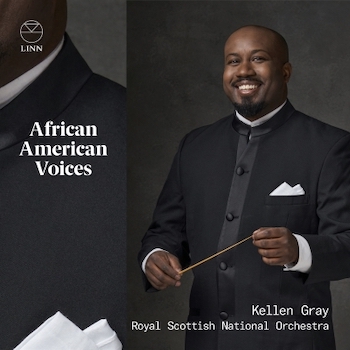Classical Music Album: “African American Voices”
By Jonathan Blumhofer
Overall, this is a strong program done in by unsatisfying recorded sound.
 Here’s an album that, on paper, is wonderful. William Levi Dawson’s Negro Folk Symphony and William Grant Still’s Afro-American Symphony are substantial, great American symphonies. George Walker’s Lyric for Strings is a gem. This is fare that ought to be played and recorded regularly and widely.
Here’s an album that, on paper, is wonderful. William Levi Dawson’s Negro Folk Symphony and William Grant Still’s Afro-American Symphony are substantial, great American symphonies. George Walker’s Lyric for Strings is a gem. This is fare that ought to be played and recorded regularly and widely.
So, to begin, credit is due the Royal Scottish National Orchestra (RSNO) and its assistant conductor Kellen Gray for vigorously performing and committing these pieces to disc. To be sure, the ensemble is professional: the notes and rhythms are all there, even if it’s the spots that sound like Dvorak (especially in the Dawson) that sound the most natural. Gray’s command of the music seems solid. The readings are fluid and, when fast, often dance nimbly.
The disc’s problems, such as they are, stem from its engineering. In particular, the orchestral sound lacks depth and isn’t clearly defined. As a result, Gray’s interpretive decisions get lost, literally, in the mix.
Take the Negro Folk Symphony. Even in the first movement’s opening bars, the harp’s fortissimo runs are completely covered by the rest of the ensemble. This bodes ill. Subsequent textures are consistently muddled: what’s supposed to be in the foreground? Background? Who knows. Surely 40 string instruments playing to the hilt shouldn’t have the same presence as 10 wind players doing the same. Yet sometimes here the winds win out. That’s problematic.
Accordingly, the Symphony’s structure is basically reduced to terms of dynamics, the loud parts and the quiet ones (the sections that are supposed to fall in between often come out sounding soft). As a result, this recording of the Negro Folk Symphony emerges largely as a frustrating study in muffled inaudibility or rowdy explosiveness.

Assistant RSNO conductor Kellen Gray.
Happily, the Still fares better. Yes, the recorded sound is still uneven, but the balance of the ensemble is more natural. Accordingly, the opening movement’s solos (especially for muted trumpet) proceed colorfully. Likewise, the Adagio’s rich-toned woodwind and viola moments sing, and the Scherzo’s humorous syncopations gambol – a bit heavy-footedly, yes, but with real spirit. The finale’s coda is aptly mighty.
Sitting in between these bigger scores is Walker’s gorgeous Lyric. As in the other works, the performance would benefit from a bigger sonic profile, though Gray draws out the music’s unaffected mellifluousness well.
Overall, then, this is a strong program done in by unsatisfying recorded sound. True, one comes away with the sense that encountering this conductor, orchestra, and repertoire in person is a completely different experience. But that means that the top choices for recordings of this music remain either Neeme Järvi’s 30-year-old efforts with the Detroit Symphony or, for the Dawson, Stokowski’s classic performance with the American Symphony.
Jonathan Blumhofer is a composer and violist who has been active in the greater Boston area since 2004. His music has received numerous awards and been performed by various ensembles, including the American Composers Orchestra, Kiev Philharmonic, Camerata Chicago, Xanthos Ensemble, and Juventas New Music Group. Since receiving his doctorate from Boston University in 2010, Jon has taught at Clark University, Worcester Polytechnic Institute, and online for the University of Phoenix, in addition to writing music criticism for the Worcester Telegram & Gazette.
